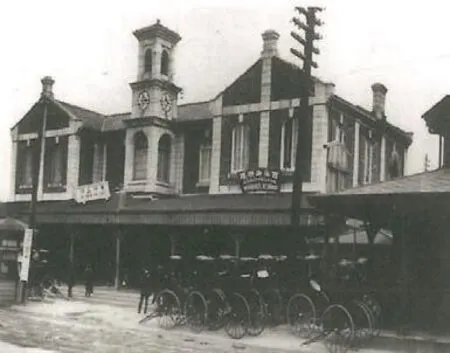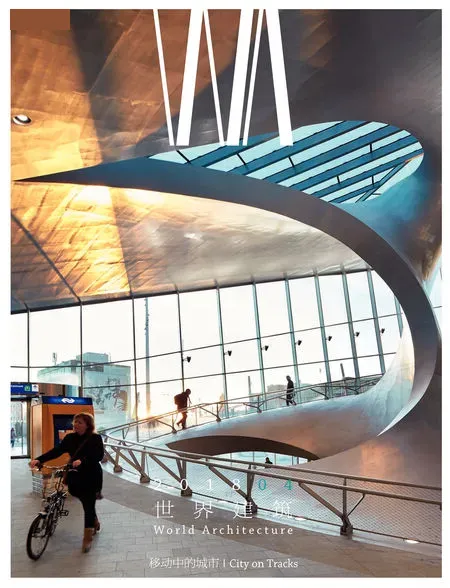京都站大楼未来百年保护策略
高浦敬之,山本博史/Yoshiyuki Takaura, Hiroshi Yamamoto徐知兰 译/Translated by XU Zhilan
1 自引进铁路运输系统迄今的历史回顾
日本于1872年引进了铁路运输系统。当时国营铁路的铺设主要用于物资运输和军事目的。伴随着产业的现代化进程,工业产品也被列为运输对象,并成为铁路运输的核心内容。此后,客运业务蓬勃发展,由于公路和汽车的发展,铁路货运量随之衰减。1964年之后,国营铁路系统持续出现赤字。1987年国营铁路系统民营化之后,货运业务被保留下来,但对铁路系统以客运服务为主要目的进行了改造。
日本铁路最初使用的燃料是煤炭,其后很早改为柴油和电力驱动,而铁路现在则成为主流的交通工具。因此,整个运输系统都发生了变化。
国营铁路系统主要面向长距离运输的业务,其火车站大多分布在城市周边地区。而后来发展起来的民营铁路则在最初铺设铁轨时就用列车将其车站与国营铁路系统的车站相衔接。由此,火车枢纽站得以形成并最终发展为城市的中心商业区。
2 京都站改造和京都站建设项目
京都于794年仿照中国长安城建成。1877年,在内外城之间的交界处建设了最早的京都站。(图1)第二代京都站于1915年建成,为满足日本天皇即位的条件在仓促间建设完成,并于1950年毁于一场大火。(图2)为了火灾后尽快重建,第三次京都站的建设也于1951年突击完成,它持续使用了46年,直到目前的京都站于1997年建成为止。(图3)正如我们能从这段历史了解到,京都站的屡次建设都很难称得上从一开始就有良好的规划,车站也同样设在城郊地区。
现在的京都站大楼于1997年建成,是第4代京都站。(图4)在建设期间,和私营铁路一样,近铁线、京都城市交通局的地铁、公共汽车、出租车等都已成为公共交通系统中的一环,而人们对于传统城镇周边地区在商业方面仍保留着过去的印象。1987年,国营铁路系统也完成了民营化的过程,在建设第4代京都站的时候,人们决定把它建成一座EKIBIRU1),而不仅仅是一座火车站。由此,火车站在整个EKIBIRU中仅占有5%的面积,它变成了一座囊括百货商店、购物中心和高级酒店的综合建筑。(图5)这部分归功于京都EKIBIRU的建成,同时京都站周边区域的商业潜力也由此得到了提升。
在东京和大阪那样的大城市里,EKIBIRU的建设作为交通运输终端的开发过程已经重复了许多次,所以人们很难理解它为周边地区熙熙攘攘的商业繁荣景象所带来的影响。然而,在京都的例子里,EKIBIRU建筑于20年前在火车站的旧址上突然建成,于是我们能很容易理解火车站建设工程的影响力。(图6)
3 京都站大楼的挑战与倡议
京都EKIBIRU已经建成20多年,在此期间,社会经历了沧桑巨变,有些人认为感觉相当于传统意义上50年的变化。那么,究竟发生了哪些变化?
日本建筑的主体大多是木质结构,城市面貌经由火灾、地震、洪水等事件得到逐步更新。因此,我认为日本民众已经接受了建筑是一股潮流、并非固定不变的认识。
在经济活动日渐增长的过程中,人们在大拆大建的同时思考建筑潮流,这两种想法并行不悖。
1990年举办了京都EKIBIRU的国际竞赛。当时的日本正处于泡沫经济时代,许多日本人认为这种局面将永远持续下去。而在泡沫经济将近尾声之时,京都EKIBIRU也于1997年建设完成。这一年也是《联合国气候变化公框架公约》第三次缔约方会议在京都召开之时,会议签署了《京都议定书》。因此,这座建筑完成之时也正值社会重大转变之际,有许多新的课题亟待应对。
考虑到经济合理性,我们再也无法重建这座拥有丰富空间的枢纽站建筑。(图7)当时建筑能够建成的原因是,人们认为在整个社会转向可持续发展方式之前,经济增长的情况将一直持续下去。所以,想要再建一座这样的枢纽站非常困难。基于这些原因,为了能长期持续地使用这座建筑,我们开始以前所未料的方式做出各种努力,直到现在也同样如此。仅仅将作为轨道交通枢纽站的建筑物当作文化遗产对待无法延长其使用寿命。作为民营铁路的重要营收来源,它还必需满足经济方面的合理性,并能永远提供“积极的服务”来适应社会的变迁。在保护优秀建筑的同时,也很有必要从硬件功能和建筑自身存在的理由两方面入手跟上时代的变化。(图8)
在价值观得到更新的当今社会,为了实现京都EKIBIRU未来百年的维护使用,我们在建筑的硬件方面采取了三项主要措施——应对气候变化问题的措施、发生灾害事故时的持续运营预案、以及作为社会公共集散地的空间利用方案。比起为这三大主题策划特殊项目的方式,我们更倾向于利用这些机

1 第一代京都站/The fi rst Kyoto Station

2 第二代京都站/The second Kyoto Station
1 Review from the introduction of railway system to today
The railway system was imported into Japan is 1872 year. In the national railroad at that time,railroads were laid for resource transportation and military purposes. In addition to the modernisation of industries, industrial products have been added to transportation targets and cargo has become the centre of railway transportation. Thereafter passenger transport expanded, cargo transport declined due to the development of roads and cars. From 1964 year, the national railroad became a def i cit. After the privatisation of the national railroad in 1987 year,cargo transport remained, but the railroad was to be rebuilt mainly on passenger transport.
Coal was the fuel at first, but the power changed to diesel and electricity before long, and the train now occupies the mainstream of the vehicle. As a result, the whole transport system has also changed.
The railway station of the national railroad which is mainly aimed at long distance transport is often located in the periphery of the city. And the late developed privately owned railroad was laid from the beginning in a form connected to the station of the national railroad using a train. In this way the railway terminal was formed and eventually became the central commercial area of the city.
2 Transition of Kyoto Station and the Kyoto Station Building Project
Kyoto was built in 794 year following the city of Chang’an in China. The fi rst Kyoto station was built around the city which is the boundary between the inside and the outside of the city in 1877. (Fig.1)The second Kyoto station was built in the 1915 in a sudden construction to be in time for the imperial position of the Emperor, and it was destroyed in a fire in 1950. (Fig.2) Kyoto station of the third generation was completed in 1951 with a sudden construction for the rebuilding of the fi re, and was used for 46 years until the current Kyoto station completed in 1997. (Fig.3) As you can see from this history, it was difficult to say that the stations were well planned for the first to the third generations,and the location was also around the city.
The current Kyoto station is completed in 1997,and it is the 4th generation. (Fig.4)
At the time of construction, it was at the point of public transport such as Kintetsu, Kyoto

5 建筑布局/Building Composition1-京都剧院/Kyoto Theatre2-GRANVIA京都酒店/Hotel GRANVIA Kyoto3-北派出所/North police station4-京都站大楼专门店街The CUBE美食街/Shopping Mall "The CUBE"Goumet (11F)5-京都拉面小路/RAMEN KOJI (10F)6-公共服务设施/Public Service (8,9F)7-JR京都伊势丹/JR Kyoto ISETAN (B2~11F)8-停车场/Parking9-石头博物馆/Stone Museum10-JR中央验票口/JR Central Gate11-京都站大楼专门店街The CUBE/Shopping Mall "The CUBE" (1F)12-南北自由通道/Pedestrian Walkway (2F)13-大楼梯/Great Staircase
项目信息/Credits and Data
功能/Program: 包含京都站、商场、宾馆、剧院以及专门店的综合建筑/Complex building including Kyoto Station,department store, hotel, theatre, specialty store
建筑设计/Architect: 原广司/Hiroshi Hara
总建筑面积/Total Floor Area: 235,942m2
基地面积/Site Area: 380,000m2
结构/Structure: 地上:钢结构;地下:钢筋混凝土结构/above ground: steel; basement: steel framed reinforced concrete
层数/Floor Number: 地上16层,地下3层/above ground:16 fl oors; basement: 3 fl oors
建筑高度/Height: 60m
竣工时间/Completion: 1997.07
京都站大楼访客数/The Number of Visitors in Kyoto Station Building: 33,920,000 (1997) → 34,350,000 (2016)京都站乘客数/The Number of Passenger in Kyoto Station:160,000 (1997) → 200,000 (2016)City Transportation Bureau, subway, bus, taxi etc as private railway. Commercially, the impression of the surrounding area of the traditional town still remained. In 1987, the national railroad is privatised, at the time of construction of the 4th generation, it was decided to be built as a EKIBIRU1)instead of a railway station. As a result, the proportion of the station in EKIBIRU was only 5%,it became a complex building including department store, shopping centre, hotel. (Fig.5) Partly due to completion of the Kyoto EKIBIRU, the position around Kyoto station in Kyoto's commercial potentials improved.
In large cities such as Tokyo and Osaka,the construction of EKIBIRU has been repeated many times during the development process as a railway terminal, so it is difficult to understand the impact on the commercial bustle around the station. However, in the case of Kyoto, EKIBIRU was suddenly made in the place where it was a railroad station 20 years ago, so it was easy to understand the impact of the station building construction.(Fig.6)
3 Issues and Initiatives in Kyoto Station Building
Twenty years have passed since the Kyoto EKIBIRU was completed. The change of society during this time is large, some people compare to the change of 50 years if it is a conventional feeling.What was the change like?
The main structural parts of Japanese buildings are wood, and the city has been renewed due to fi re,earthquake, floods and so on. Therefore, I think that Japanese accepted the building as a fl ow rather than as a stock.
In the process of expanding economic activity,thinking of scrap & build and thinking of building as a fl ow coexisted without discomfort.
The international competition of Kyoto EKIBIRU was carried out in 1990. At that time Japan was in the state of the bubble economy, and many Japanese thought that this condition would continue. After the end of the bubble economy, the Kyoto EKIBIRU was completed in 1997. That year was also the year when COP 3 was held in Kyoto, and the Kyoto Protocol was signed. When the building was completed it was a major turning point of society and it became necessary to deal with new issues.
This building has rich spaces that can never be会替换老旧的设施,并以同时符合企业经济利益的方式来开展工作。

6 京都站周边变迁/Transformation around Kyoto Station

7 从经济合理性的观点出发的话,这样丰富的空间绝无可能实现/Rich spaces that can never be realized from the viewpoint of economic rationality7a 大楼梯/Big Staircase7b 中庭/Atrium

8 长期改造计划/Long term renovation plan

9 绿水步廊:城市化枢纽站中自然的恢复与启示/Ryokusuihoro:Nature restoration and enlightenment at urbanized terminals(本文图片均由京都站大楼开发株式会社提供/All images are provided by Kyoto Station Building Development Corporation)
到现阶段,我们已经收获了丰硕的成果。通过使用调试方法,我们更换了空调制热系统,它原先占据了一半的建筑耗能,在系统更换期间,建筑仍可持续使用,直至新系统全部完成为止。CO2排放量从4.8万t降至2.8万t。整座建筑耗能减少了30%,仅热耗能一项减少60%。由于京都EKIBIRU的CO2排放量占据了京都全市的72%,其成果具有划时代的意义。同样,人们常常以为在京都铁路枢纽站所在的城市中心,修复自然环境困难重重。然而,通过利用京都站丰富多变的建筑空间,我们建成了一条生态廊道(生态网落)。通过利用车站吸引人流和传播信息的优势与潜力,我们与各类行政机构和关注环境问题的组织合作,参与多项活动,宣传教育保护生物多样性的重要性。(图9)□realised from the viewpoint of economic rationality.(Fig.7) It can be realised as it is considered that the expansion of economic activity will continue even before the society steers forward in a sustainable direction. In this way, it is very difficult to make such a building again. For such reasons, we have begun to undertake efforts that have not been thought much in Japan until now to continue using this building for a long time. A building as a railroad terminal does not prolong life simply by preserving it as a cultural asset.It is necessary to satisfy the economic rationality as one of the important revenue sources of privatised railway and always respond to social change with"active service". While protecting good buildings,it became necessary to catch up with changes in society in terms of the function as hardware and the existence reason of the building itself. (Fig.8)
In the society with new values, there are three major things working on the hardware side of the building to sustain the Kyoto EKIBIRU for 100 years. These are initiatives for climate change problems, business continuity plan in disasters, and utilisation of space as a social contribution. Rather than making special projects for these three themes,we are taking advantage of opportunities to replace aging facilities and are working in a way that also matches economic rationality as a company.
As a concrete result at the present stage, we changed the air conditioning heat source system which uses half of building energy while continuing to use building to a completely new system by commissioning method. And CO2emissions were reduced from 48,000t to 28,000t. The reduction is 30% for the entire building and 60% for the heat source alone.
Since the Kyoto EKIBIRU discharged 0.72 of the total CO2emissions in Kyoto city, this result is epoch-making event. Also, it is often thought that restoration of nature is difficult in the centre of the city where the railway terminal is located. However,by utilising the varied and rich space of the Kyoto station building, it contributes to the formation of a living corridor (ecological network). And by taking advantage of the attracting power and the potential of information dissemination, we are engaged in activities to educate the importance of conserving biodiversity with various organisations addressing administrative and environmental issues. (Fig.9)□

